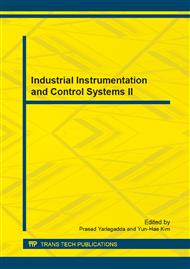[1]
IF Akyildiz, W Su, Y Sankarasubr- amaniam, ECayirci. Wireless sensor networ- ks: a survey. Computer Networks (S1389 -1286), 2002, 38(4): 393-422.
DOI: 10.1016/s1389-1286(01)00302-4
Google Scholar
[2]
Akyildiz L F, Weilian S, Sankarasubra- maniam Y, et al. A Survey on Sensor Networks. IEEE Communications Magazine, 2002, 40(8): 102-114.
DOI: 10.1109/mcom.2002.1024422
Google Scholar
[3]
Sagduyu Y E, Ephremides A. The Problem of Medium Access Control in Wireless Sensor Networks. IEEE Transon Wireless Communications, 2004, 11(6): 44-53.
DOI: 10.1109/mwc.2004.1368896
Google Scholar
[4]
Lin T-H, Kaiser W J, Pottie G J. Inte- grated Low-Power Communication System Design for Wireless Sensor Networks. IEEE Communications Magazine, 2004, 42(12): 142-150.
DOI: 10.1109/mcom.2004.1367566
Google Scholar
[5]
W. Heinzelman, A. Chandrakasan and H. Balakrishnan. Energyefficient Communicat- ion Protocol for Wireless Sensor Net- works. Proceeding of the Hawaii Inter- national Conference on System Sciences, H- awaii , January 2000: 1-10.
Google Scholar
[6]
F. Xiangning and S. Yulin. Improvement on LEACH Protocol of Wireless Sensor Ne- twork. International Conference on Sensor Technologies and Applications. 2007: 260-264.
DOI: 10.1109/sensorcomm.2007.4394931
Google Scholar
[7]
M. BaniYassein, A. Al-zou'bi, Y. Khama- yseh and W. Mardini, on LEACH Protocol of Wireless Sensor Network (VLEACH). International Journal of Digital Content- Technology and its Applications. 2009, 3(2): 132-136.
DOI: 10.4156/jdcta.vol3.issue2.yassein
Google Scholar
[8]
SHI Ye-ling, CHEN Bin-bing. Improv- ed LEACH-ID algorithm for wireless sensor networks. Journal of Computer Applic- ations, 2011, 31(2): 324 - 327.
DOI: 10.3724/sp.j.1087.2011.00324
Google Scholar
[9]
Vivek Katiyar, Narottam Chand, Gopal Chand Gautam and Anil Kumar. Imp- rovement in LEACH Protocol for Large -scale Wireless Sensor Networks. Proc. 2011 International Conference on Emerging Trends in Electrical and Computer Technology (ICETEC) . India, March (2011).
DOI: 10.1109/icetect.2011.5760277
Google Scholar
[10]
C. Jing, T. Gu and L. Chang, ESCAL: an energy-saving clustering algorithm based on LEACH, in Proceedings of the IEEE Int- ernational Symposium on Knowledge Acqu- isition and Modeling Workshop (KAM '08), p.403–406, December (2008).
DOI: 10.1109/kamw.2008.4810509
Google Scholar
[11]
Wei Bo, Hu Han-ying, Fu Wen. An Imp- roved LEACH Protocol for Data Gathering and Aggregation in Wireless Sensor Netwo- rks. International Conference on Computer and Electrical Engineering, (2008).
DOI: 10.1109/iccee.2008.59
Google Scholar
[12]
LIN N an, SH IW ei- hang. Simulation Research ofW ireless Sensor Networks Bas- ed on LEACH Protocol. Computer Simulat- ion , 2011, 28(1): 178 - 181.
Google Scholar
[13]
Jeong Hee-jin, Nam Choon-sung, Jeong Yi-seok, and Shin Dong-ryeol. A mobile Agent based LEACH in wireless sensor networks. The 10th International Conference on Advanced Communication Technology Phoenix Park, Korea, 2008: 75-78.
DOI: 10.1109/icact.2008.4493715
Google Scholar
[14]
WANG Pei-dong, LI Hai-dong, XU Yan. Improvement of LEACH based on Mobile Agent. Communications Technology, 2009, 42(213): 151-153.
Google Scholar
[15]
M Chen, S Gonzlez, Y Zhang, V C Leung. Multi-agent itinerary planning for sensor networks. Proceedings of theIEEE 2009 International Conference on Heter- ogeneous Networking for Quality, Reliability, Security and Robustness (QShine 2009), Las Palmas de Gran Canaria, Spain., 2009. USA: IEEE, (2009).
DOI: 10.1007/978-3-642-10625-5
Google Scholar
[16]
CAI Wei, CHEN Zhi-jun, FENG Xin - long, ZENG Wen-hua. Multi-Agent Group-ing Algorithm in Wireless Sensor Networ- ks. Journal of System Simulation, 2010, 22 (12): 2890-2894.
Google Scholar
[17]
V . Loscri, G. Morabito, and S. Marano, A two-level hierarchy for low-energy adap- tive clustering hierarchy. Proceedings of IEEE VTC Conference 2005. 2005, (3): 1809 – 1813.
DOI: 10.1109/vetecf.2005.1558418
Google Scholar
[18]
Min Chen, Laurence T. Yang, Taek- young Kwon, Liang Zhou, Minho Jo. Itine- rary Planning for Energy-Efficient Agent Communications in Wireless Sensor Net- works. IEEE Transactions On Vehicular Tec- hnology, vol. 60, NO. 7, December 2011: 3290 -3299.
DOI: 10.1109/tvt.2011.2134116
Google Scholar
[19]
HUANG Hai ping, WANG Ruchuan, SUN Li Juan, SHA Chao. A Power Manage- ment Mechanism for Wireless Sensor Netw- orks Used by Mobile Agents. COMPUTER ENGINEERING & SCIENCE, 2010, 6(32): 9-12.
Google Scholar
[20]
YU Hua ping, GUO Mei, HU Jie. Delay performance analys is for mobile Sinks Wireless sensor networks. Application R- esearch of Computers, 2010, 27(1): 317-322.
Google Scholar


